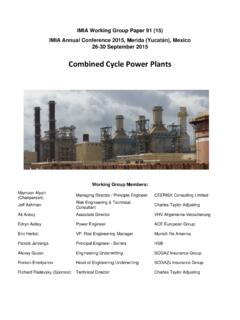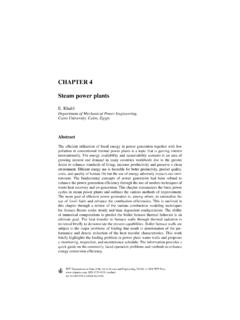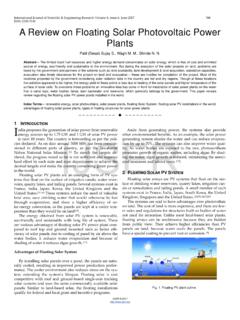Transcription of Dynamic Models for Wind Turbines and Wind Power Plants
1 Dynamic Models for Wind Turbines and Wind Power Plants January 11, 2008 May 31, 2011 Mohit Singh Surya Santoso (Principal Investigator) The University of Texas at Austin Austin, Texas nrel is a national laboratory of the Department of Energy, Office of Energy Efficiency & Renewable Energy, operated by the Alliance for Sustainable Energy, LLC. Subcontract Report nrel /SR-5500-52780 October 2011 Contract No. DE-AC36-08GO28308 National Renewable Energy Laboratory 1617 Cole Boulevard Golden, Colorado 80401 303-275-3000 Dynamic Models for Wind Turbines and Wind Power Plants January 11, 2008 May 31, 2011 Mohit Singh Surya Santoso (Principal Investigator) The University of Texas at Austin Austin, Texas nrel Technical Monitor: Eduard Muljadi Prepared under Subcontract No. XEE-8-77567-01 nrel is a national laboratory of the Department of Energy, Office of Energy Efficiency & Renewable Energy, operated by the Alliance for Sustainable Energy, LLC.
2 Subcontract Report nrel /SR-5500-52780 October 2011 Contract No. DE-AC36-08GO28308 This publication received minimal editorial review at nrel . NOTICE This report was prepared as an account of work sponsored by an agency of the United States government. Neither the United States government nor any agency thereof, nor any of their employees, makes any warranty, express or implied, or assumes any legal liability or responsibility for the accuracy, completeness, or usefulness of any information, apparatus, product, or process disclosed, or represents that its use would not infringe privately owned rights. Reference herein to any specific commercial product, process, or service by trade name, trademark, manufacturer, or otherwise does not necessarily constitute or imply its endorsement, recommendation, or favoring by the United States government or any agency thereof.
3 The views and opinions of authors expressed herein do not necessarily state or reflect those of the United States government or any agency thereof. Available electronically at Available for a processing fee to Department of Energy and its contractors, in paper, from: Department of Energy Office of Scientific and Technical Information Box 62 Oak Ridge, TN 37831-0062 phone: fa x: email: Available for sale to the public, in paper, from: Department of Commerce National Technical Information Service 5285 Port Royal Road Springfield, VA 22161 phone: fax: email: online ordering: Cover Photos: (left to right) PIX 16416, PIX 17423, PIX 16560, PIX 17613, PIX 17436, PIX 17721 Printed on paper containing at least 50% wastepaper, including 10% post consumer waste. Abstract Manufacturer-specific Models of wind Turbines are favored for use in wind Power interconnection studies.
4 While they are detailed and accurate, their usages are limited to the terms of the non-disclosure agreement, thus stifling model sharing. The primary objective of the work proposed is to develop universal manufacturer-independent wind Power plant Models that can be shared, used, and improved without any restrictions by project developers, manufacturers, and engineers. Each of these Models includes representations of general turbine aerodynamics, the mechanical drive-train, and the electrical characteristics of the generator and converter, as well as the control systems typically used. To determine how realistic model performance is, the performance of one of the Models (doubly-fed induction generator model) has been validated using real-world wind Power plant data. This work also documents selected applications of these Models . 4 Contents Abstract.
5 4 1. Introduction ..9 Background and Motivation .. 9 The changing Power 9 Wind Power integration and wind turbine modeling .. 9 Research Objectives .. 10 Wind Turbine 11 Modern utility-scale wind Turbines .. 11 Classification of wind Turbines .. 11 13 Brief Summary .. 13 2. Modeling of Fixed-Speed (Type 1) Wind Turbine Generators ..14 Introduction to Wind Turbine Modeling .. 14 Aerodynamics .. 15 A brief introduction to the aerodynamics of wind 15 Aerodynamic Block .. 16 Tip-speed ratio 16 Rotor Power coefficient (CP) calculation .. 17 Aerodynamic torque calculation .. 17 Mechanical Drivetrain .. 18 Induction Generator .. 21 Control Block .. 22 Complete Model Implemented in PSCAD/EMTDC .. 22 Power Curve for Fixed-Speed 22 Dynamic 23 24 3. Modeling of Variable-Slip (Type 2) Wind Turbine Rotor Resistance Control 25 Induction machine equivalent 25 Effect of rotor resistance change on equivalent circuit and torque and Power equations.
6 27 5 Methods for Rotor Resistance 28 Model 28 Two-loop PI controller based on output Power and rotor 29 Dynamic 31 32 4. Modeling of DFIG (Type 3) Wind Power Plants : Current Source Representation ..33 Introduction to DFIG Technology .. 33 Prior Work on DFIG Dynamic Modeling .. 33 Work done under IEA Wind Annex 33 Three-Phase Model: Development and Implementation .. 34 Doubly-Fed Induction Generators: Basic 34 Modeling Approach: Use of Regulated Current Source instead of Detailed Device Models .. 39 Implementation of DFIG WPP Model in PSCAD/EMTDC .. 42 Model Development Summary .. 50 Three-Phase Model: Steady-State Performance .. 50 Method of Computing Real and Reactive Power in the qd0 Frame with Validation .. 51 Wind Power 55 Reactive Power Control and Less-Than-Maximum Power 57 Changes in Wind Speed.
7 60 Model Performance Summary .. 62 Three-Phase Model: Validation Using Field Data .. 63 Introduction to the Validation 63 Collector 63 Steady-State Validation: Pre-Fault .. 65 Dynamic Performance .. 72 78 5. DFIG (Type 3) Wind Turbine Generators: Single-Machine Detailed Model ..79 79 Model 79 Aerodynamic and Mechanical drivetrain 79 Reference Power 80 Pitch control 80 Induction 81 Rotor and grid side converter control for 81 Unit transformer and grid representation .. 86 6 Complete model implemented in PSCAD/EMTDC .. 86 Model 86 Power 86 Independent real and reactive Power control .. 88 Pitch control .. 90 Dynamic 90 92 6. Modeling of Full-Converter (Type 4) Wind Turbine Generators Employing Permanent Magnet Alternators.
8 93 93 Model 93 Aerodynamic and mechanical drivetrain 94 Reference Power calculation from wind speed .. 94 Pitch control 94 Permanent magnet alternator .. 95 Rectifier and buck/boost converter for DC-link voltage control .. 96 Inverter .. 96 Unit transformer and grid representation .. 98 Complete model implemented in PSCAD/EMTDC .. 99 Model 99 Power 99 Independent real and reactive Power control .. 101 Pitch control .. 102 Dynamic 103 104 7. Conclusion and Future Conclusion .. 105 Future 105 Appendices ..106 Appendix A: Wind Turbine Ratings and Parameters ..107 Fixed-Speed (Type 1) Single Turbine Estimated Ratings and Parameters (note: parameters modified for consistency across turbine types) .. 107 Variable-Slip (Type 2) Single Turbine Estimated Ratings and Parameters (note: parameters modified for consistency across turbine types) .. 107 Doubly-Fed Induction Generator (Type 3) Single Turbine Estimated Ratings and Parameters (note: parameters modified for consistency across turbine types).
9 108 7 Full-Converter (Type 4) Single Turbine Estimated Ratings and Parameters (note: parameters modified for consistency across turbine types) .. 109 Appendix B: Fifth-and Third-Order Equations for Induction Fifth-Order Model .. 110 Third-Order Model .. 110 8 1. Introduction Background and Motivation The changing Power system The bulk Power system was called the largest, most complex machine ever devised by man by Charles Steinmetz in the early 1900s, and its complexity has increased considerably since then. The basic characteristics of the Power system in the 20th century were that they were comprised of 3-phase AC systems at constant voltage, used synchronous AC machines (alternators) running at constant frequency for generation, and transmitted Power over significant distances [1].
10 Our understanding of the Power system has been based on these underlying characteristics. However, in the 21st century, these characteristics no longer apply universally and our understanding of Power system concepts is no longer quite as firmly entrenched. The Power system today is expected to integrate a variety of AC and DC systems in all three areas: generation, transmission and distribution. It is expected to be able to handle both synchronous and asynchronous generators, centralized and distributed resources, and to handle inherently controllable as well as inherently intermittent and variable sources of energy. Moreover, the need for a large centralized bulk Power system as a one-size-fits-all solution for every energy need is being questioned, and smaller grids ( microgrids ) are gaining currency in niche applications. These grids still require the bulk Power system to back them up. These changes in the bulk Power system are a result of a multitude of factors [2].

















